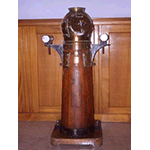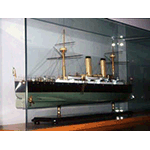Accademia Navale di Livorno [Livorno Naval Academy]
The Naval Academy, an officers’ training school for the Navy, was founded at Livorno on November 6, 1881 by uniting the naval schools of Genoa and of Naples, at the initiative of Admiral Benedetto Brin, Minister of the Navy at the time. After considering various proposals, it was decided to use as headquarters the area occupied by the Lazzaretto di San Jacopo, built under Grand Duke Ferdinando II de' Medici as a place of quarantine for the crewmen of ships arriving from the Near East. The project was commissioned of the Livornese Angiolo Badaloni. In 1913 the area occupied by the Lazzaretto di San Leopoldo, built in the second half of the 18th century, was also annexed to the Academy. From 1923 to 1926 the Naval Academy also housed the Aeronautic Academy. During World War II, consequent to bombing in July 1943, the Academy had to abandon its premises in Livorno and move to Venice. Two months later it moved again, this time to Brindisi, where it remained until 1946, when it returned to Livorno. Intense rebuilding work began immediately and was concluded within a few years. New buildings were added later, among them the Palazzo Studi in 1966, with modern scientific laboratories and specialised classrooms. Today the Naval Academy, a great longitudinal building surmounted by a square tower with clocks on three faces, is attended by 1,250 Officers and Officers in Training each year.
The Academy has a collection of copper dies of nautical charts, made by the Genoa Hydrographic Institute in the late 19th and early 20th centuries, and a collection of model ships in wood, metal and plastic, dating from the second half of the 19th to the middle of the 20th century. Some of the models, owned by the Orlando Naval Shipyards of Livorno, have been kept here on loan since 1974. The scientific instrumentation consists of nautical instruments (sextants, anemometers, barometers, goniometers, compasses and binnacles, depth sounders and satellite navigators) dating from the second half of the 19th century to the present. The instruments coming from naval craft, were collected by the Genoa Hydrographic Institute and then transferred to the Naval Academy for teaching purposes. The Academy also has an optical-mechanical planetarium, the last one built by the Officine Galileo of Florence, installed in 1981.
****************************
Texts by Francesco Marchetti
English translation by Catherine Frost
Last update 12/feb/2008





